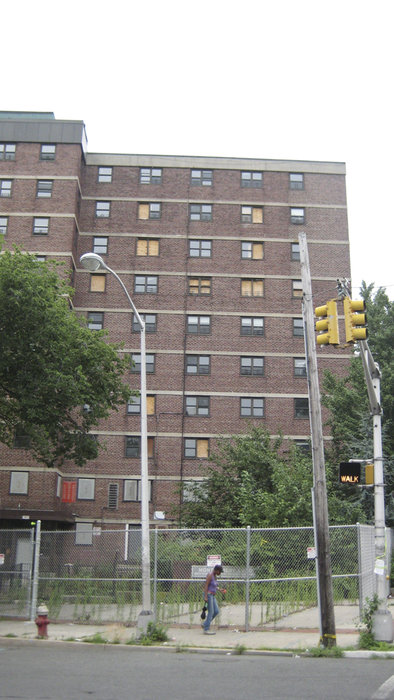Montgomery Street, a road that extends from downtown Jersey City to McGinley Square, has been described as a “raceway” that motorists use to get from one end of the city to the other, but one that offers little in the way of destinations that might make people stop and stay for a while.
The street intersects the St. Peter’s University campus and is home to the Beacon, the luxury Art Deco-style condo and rental development that is still being forged from the old Jersey City Medical Center site. But Montgomery Street lacks restaurants, shops, parks, and other amenities that might foster community and bring the corridor to life.
City officials hope, however, that winning a $30 million grant from the U.S. Department of Housing and Urban Development (HUD) might change that and help bring the Montgomery Street corridor to life.
In September, the city Housing Authority will submit a grant application to HUD to tear down the Montgomery Gardens public housing project. In its place, with the help of the HUD grant, the city would build a new mixed-use, mixed-income development that would include new residential housing, parking, pocket parks, a supermarket, day care center, the Beloved Community Charter School, and other features that the city hopes will revitalize the Montgomery Street corridor.
‘We are the elephant in the room.’ – Joan Pollack
____________
Competition for the $30 million grant HUD grant, distributed through the agency’s Choice Neighborhoods Initiative, will be stiff. Last year the Jersey City Housing Authority was a among a handful of finalists for a Choice Neighborhoods grant but ultimately fell short and did not receive a grant.
Cities that did receive Choice Neighborhoods grants in the last round of funding included San Antonio, Texas; Seattle, Wash.; Tampa, Fla.; and Cincinnati, Ohio.
This year, the city plans to revise and resubmit its application. HUD has announced that it will award four $30 million grants in the next round of Choice Neighborhoods funding. The Housing Authority last week held a community meeting to get input from residents regarding what features they would like to see included in the project. About 50 residents from McGinley Square, the Beacon, Montgomery Gardens, and St. Peter’s University attended the meeting and made recommendations.
Human needs, including beautification
“I think there should be an affordable exercise facility in the area, kind of like the [recently renovated] McBurney YMCA in New York,” said Kara Hrabosky. The McBurney Y features an indoor pool, weights, cardio equipment, yoga and fitness classes, but is hundreds of dollars cheaper to join than private health clubs that offer comparable options.
Hrabosky said she would also like to see an affordable farmer’s market brought to the area.
Since the grant the city will apply for is administered by HUD, applicants get points for incorporating services and amenities that serve the unique needs of low and moderate income people who may have limited access to these services elsewhere.
Activist Charlene Burke recommended that the grant include the development of bike share and car share programs.
Many residents said they would like to see some grant money set aside for façade improvement for storefronts and private residential homes, if possible, to increase the area’s overall curb appeal. Similarly, residents asked that resources be found to purchase and maintain trash cans so the community will be less filthy.
“If the area looks nicer, people will be more willing to get out of their cars and walk,” said Burke.
Residents also wanted to see areas where public art projects can thrive like they do at Grove Plaza downtown.
“Things like murals and a place for outdoor concerts and performances would be good,” said Michael Griffin, program manager of the Jackson Hill Main Street Management Corporation.
Translation: Gentrification?
While residents were guardedly optimistic about the city’s plans for the area, some current and former Montgomery Gardens housing project tenants are worried about what the future will hold for them if HUD awards Jersey City a Choice Neighborhoods grant.
“I’m worried this is just going to translate into gentrification,” said longtime Montgomery Gardens resident Jacqueline Alsbrook. “By law, they have to replace the public housing units that are being destroyed. But they aren’t required to build those units at this exact site. I think they will do everything they can to build our units someplace else. I know that when I look out my window on the eighth floor, I can see the New York skyline. I think that’s there now. And the people that will be living on Montgomery Street will be middle class folks.”
Griffin was less skeptical.
“I don’t think that is going to happen,” Griffin said. “I think they’re going to do this right. They’ve been involving the community throughout the process and getting feedback. So I don’t foresee that happening. If it does happen, then that’s something we will have to deal with. But so far, I think they are doing right by the community.”
The city’s application to HUD is due by Sept. 10.
To see more about the city’s plans for the Montgomery Street corridor, visit, www.JCHA-gov.us.
E-mail E. Assata Wright at awright@hudsonreporter.com.
